Numerical Investigation on the Aerodynamic and Aeroacoustic Characteristics in New Energy Vehicle Cooling Fan with Shroud
Abstract
:1. Introduction
2. Geometric Model and Numerical Descriptions
2.1. Geometric Model of Cooling Fan
2.2. Computational Fluid Dynamics (CFD) Method
- (1)
- model
- (2)
- Smagorinsky–Lilly Model
2.3. Ffowcs-Williams and Hawkings (FW-H) Equation
2.4. Numerical Settings
3. Computational Meshes and Experimental Validation
3.1. Evaluation of Mesh Quality
3.2. Experimental Validation
4. Results and Discussion
4.1. Aerodynamic Characteristics near the Blade and Shroud
4.2. Pressure Fluctuation near the should
4.3. Aeroacoustic Characteristics
5. Conclusions
Author Contributions
Funding
Data Availability Statement
Conflicts of Interest
References
- Suzuki, A.; Soya, A. Study on the Fan Noise Reduction for Automotive Radiator Cooling Fans; SAE Technical Paper; SAE International: Warrendale, PA, USA, 2005. [Google Scholar] [CrossRef]
- Teymourpour, S.; Mahdavi-Vala, A.; Yadegari, M.; Kia, S.; Seydi, M.; Saboohi, Z. Engineering Approach for Noise Reduction for Automotive Radiator Cooling Fan: A Case Study; SAE Technical Paper; SAE International: Warrendale, PA, USA, 2020. [Google Scholar] [CrossRef]
- Nashimoto, A.; Fujisawa, N.; Nakano, T.; Yoda, T. Visualization of aerodynamic noise source around a rotating fan blade. J. Vis. 2008, 11, 365–373. [Google Scholar] [CrossRef]
- Becher, M.; Krusche, R.; Tautz, M.; Mauß, M.; Springer, N.; Krömer, F.; Becker, S. Influence of the gap flow of axial vehicle cooling fans on radiated narrowband and broadband noise. Acta Acust. United Acust. 2019, 105, 435–448. [Google Scholar] [CrossRef]
- Luo, B.; Chu, W.; Zhang, H. Tip leakage flow and aeroacoustics analysis of a low-speed axial fan. Aerosp. Sci. Technol. 2020, 98, 105700. [Google Scholar] [CrossRef]
- Zhao, W.; Wasala, S.; Persoons, T. On the Fast Prediction of the Aerodynamic Performance of Electronics Cooling Fans Considering the Effect of Tip Clearance. IEEE Trans. Compon. Packag. Manuf. Technol. 2023, 13, 1139–1146. [Google Scholar] [CrossRef]
- Park, M.J.; Lee, D.J.; Lee, H. Experimental and computational investigation of the effect of blade sweep on acoustic characteristics of axial fan. Appl. Acoust. 2022, 189, 108613. [Google Scholar] [CrossRef]
- Azzam, T.; Paridaens, R.; Ravelet, F.; Khelladi, S.; Oualli, H.; Bakir, F. Experimental investigation of an actively controlled automotive cooling fan using steady air injection in the leakage gap. Proc. Inst. Mech. Eng. Part A J. Power Energy 2017, 231, 59–67. [Google Scholar] [CrossRef]
- Fares, O.; Weng, C.; Zackrisson, L.; Yao, H.; Knutsson, M. Numerical Investigation of Narrow-Band Noise Generation by Automotive Cooling Fans; SAE Technical Paper; SAE International: Warrendale, PA, USA, 2020. [Google Scholar] [CrossRef]
- Mo, J.; Choi, J. Numerical investigation of unsteady flow and aerodynamic noise characteristics of an automotive axial cooling fan. Appl. Sci. 2020, 10, 5432. [Google Scholar] [CrossRef]
- Wang, S.; Yu, X.; Shen, L.; Yang, A.; Chen, E.; Fieldhouse, J.; Barton, D.; Kosarieh, S. Noise reduction of automobile cooling fan based on bio-inspired design. Proc. Inst. Mech. Eng. Part D J. Automob. Eng. 2021, 235, 465–478. [Google Scholar] [CrossRef]
- Park, M.J.; Lee, D.J. Sources of broadband noise of an automotive cooling fan. Appl. Acoust. 2017, 118, 66–75. [Google Scholar] [CrossRef]
- Moreau, S. Direct noise computation of low-speed ring fans. Acta Acust. United Acust. 2019, 105, 30–42. [Google Scholar] [CrossRef]
- Chai, P.; Sun, Z.; Chang, Z.; Peng, Z.; Tian, J.; Ouyang, H. Noise characteristics of automobile cooling fan based on circumferential mode analysis. J. Eng. Gas Turbines Power 2021, 143, 121003. [Google Scholar] [CrossRef]
- Ren, K.; Zhang, S.; Zhang, H.; Deng, C.; Sun, H. Flow field analysis and noise characteristics of an automotive cooling fan at different speeds. Front. Energy Res. 2023, 11, 1259052. [Google Scholar] [CrossRef]
- Lim, T.G.; Jeon, W.H.; Minorikawa, G. Characteristics of unsteady flow field and flow-induced noise for an axial cooling fan used in a rack mount server computer. J. Mech. Sci. Technol. 2016, 30, 4601–4607. [Google Scholar] [CrossRef]
- Hu, Z.; Lu, W. Numerical investigation on performance and aerodynamic noise of high speed axial flow fans. In Proceedings of the 2017 IEEE 2nd Advanced Information Technology, Electronic and Automation Control Conference (IAEAC), Chongqing, China, 25–26 March 2017; pp. 885–889. [Google Scholar] [CrossRef]
- Moosania, M.; Zhou, C.; Hu, S. Aerodynamics of a partial shrouded low-speed axial flow fan. Int. J. Refrig. 2021, 130, 208–216. [Google Scholar] [CrossRef]
- Canepa, E.; Cattanei, A.; Mazzocut Zecchin, F. Leakage noise and related flow pattern in a low-speed axial fan with rotating shroud. Int. J. Turbomach. Propuls. Power 2019, 4, 17. [Google Scholar] [CrossRef]
- Daku, G.; Vad, J. Profile vortex shedding from low-speed axial fan rotor blades: A modelling overview. Proc. Inst. Mech. Eng. Part A J. Power Energy 2022, 236, 349–363. [Google Scholar] [CrossRef]
- Krömer, F.; Müller, J.; Becker, S. Investigation of aeroacoustic properties of low-pressure axial fans with different blade stacking. AIAA J. 2018, 56, 1507–1518. [Google Scholar] [CrossRef]
- Zhu, T.; Lallier-Daniels, D.; Sanjosé, M.; Moreau, S. Rotating coherent flow structures as a source for narrowband tip clearance noise from axial fans. J. Sound Vib. 2018, 417, 198–215. [Google Scholar] [CrossRef]
- Eberlinc, M.; Širok, B.; Hočevar, M.; Dular, M. Numerical and experimental investigation of axial fan with trailing edge self-induced blowing. Forsch. Ingenieurwesen 2009, 73, 129–138. [Google Scholar] [CrossRef]
- Pereira, M.; Ravelet, F.; Azzouz, K.; Azzam, T.; Oualli, H.; Kouidri, S.; Bakir, F. Improved Aerodynamics of a Hollow-Blade Axial Flow Fan by Controlling the Leakage Flow Rate by Air Injection at the Rotating Shroud. Entropy 2021, 23, 877. [Google Scholar] [CrossRef] [PubMed]
- Ren, G.; Heo, S.; Kim, T.H.; Cheong, C. Response surface method-based optimization of the shroud of an axial cooling fan for high performance and low noise. J. Mech. Sci. Technol. 2013, 27, 33–42. [Google Scholar] [CrossRef]
- Konikineni, P.; Sundaram, V.; Sathish, K.; Thirukkotti, S. Optimization Solutions for Fan Shroud; SAE Technical Paper; SAE International: Warrendale, PA, USA, 2016. [Google Scholar] [CrossRef]
- Zhang, X.; Zhang, Y.; Lu, C. Flow and noise characteristics of centrifugal fan in low pressure environment. Processes 2020, 8, 985. [Google Scholar] [CrossRef]
- Rui, X.; Lin, L.; Wang, J.; Ye, X.; He, H.; Zhang, Z.; Zhu, Z. Experimental and comparative RANS/URANS investigations on the effect of radius of volute tongue on the aerodynamics and aeroacoustics of a sirocco fan. Processes 2020, 8, 1442. [Google Scholar] [CrossRef]
- Boudet, J.; Cahuzac, A.; Kausche, P.; Jacob, M.C. Zonal large-eddy simulation of a fan tip-clearance flow, with evidence of vortex wandering. J. Turbomach. 2015, 137, 061001. [Google Scholar] [CrossRef]
- Reboul, G.; Polacsek, C.; Lewy, S.; Heib, S. Aeroacoustic computation of ducted-fan broadband noise using LES data. J. Acoust. Soc. Am. 2008, 123, 3539. [Google Scholar] [CrossRef]
- Shaheed, R.; Mohammadian, A.; Kheirkhah Gildeh, H. A comparison of standard k–ε and realizable k-ε turbulence models in curved and confluent channels. Environ. Fluid Mech. 2019, 19, 543–568. [Google Scholar] [CrossRef]
- Lilly, D.K. A proposed modification of the Germano subgrid-scale closure method. Phys. Fluids A Fluid Dyn. 1992, 4, 633–635. [Google Scholar] [CrossRef]
- Khelladi, S.; Kouidri, S.; Bakir, F.; Rey, R. Predicting tonal noise from a high rotational speed centrifugal fan. J. Sound Vib. 2008, 313, 113–133. [Google Scholar] [CrossRef]
- Canepa, E.; Cattanei, A.; Moradi, M.; Nilberto, A. Experimental Study of the Leakage Flow in an Axial-Flow Fan at Variable Loading. Int. J. Turbomach. Propuls. Power 2021, 6, 40. [Google Scholar] [CrossRef]
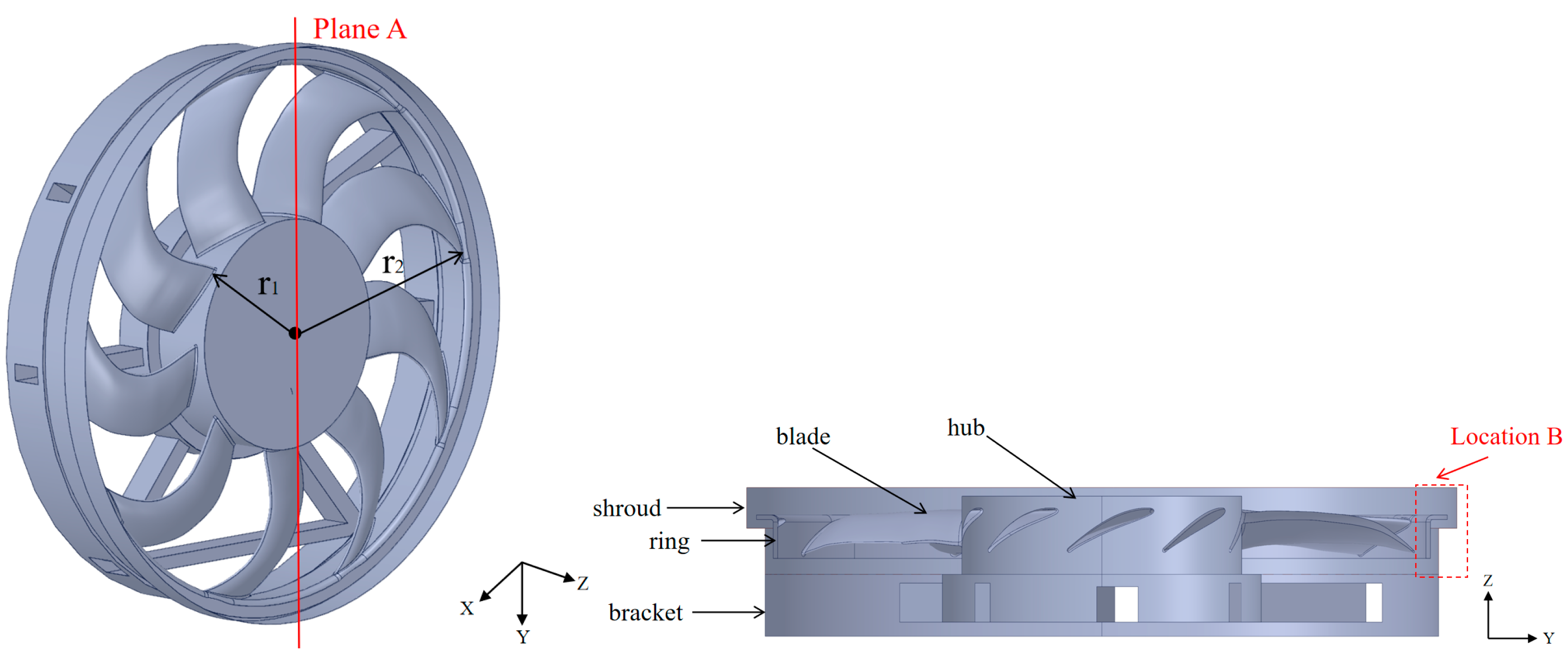
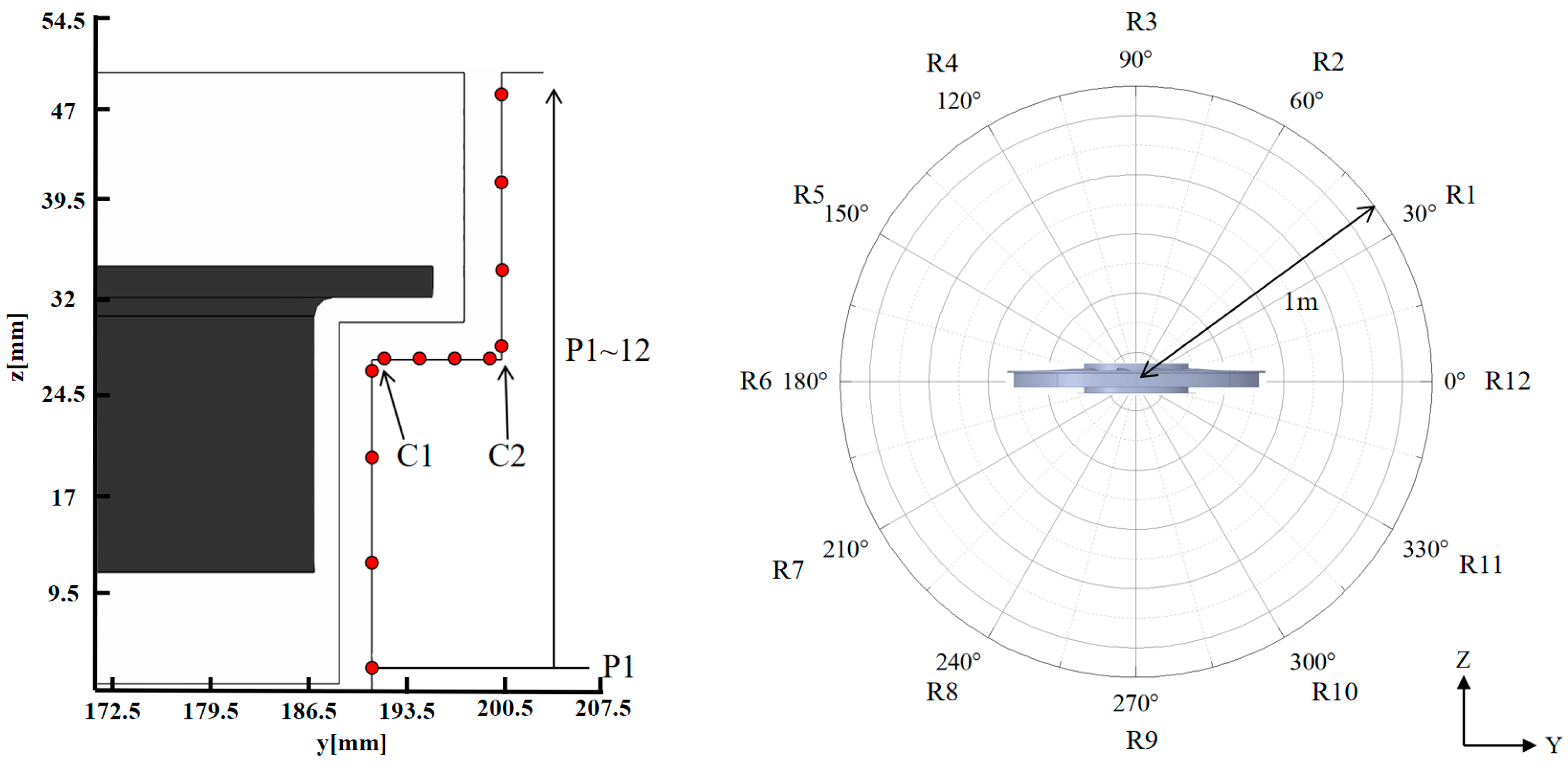


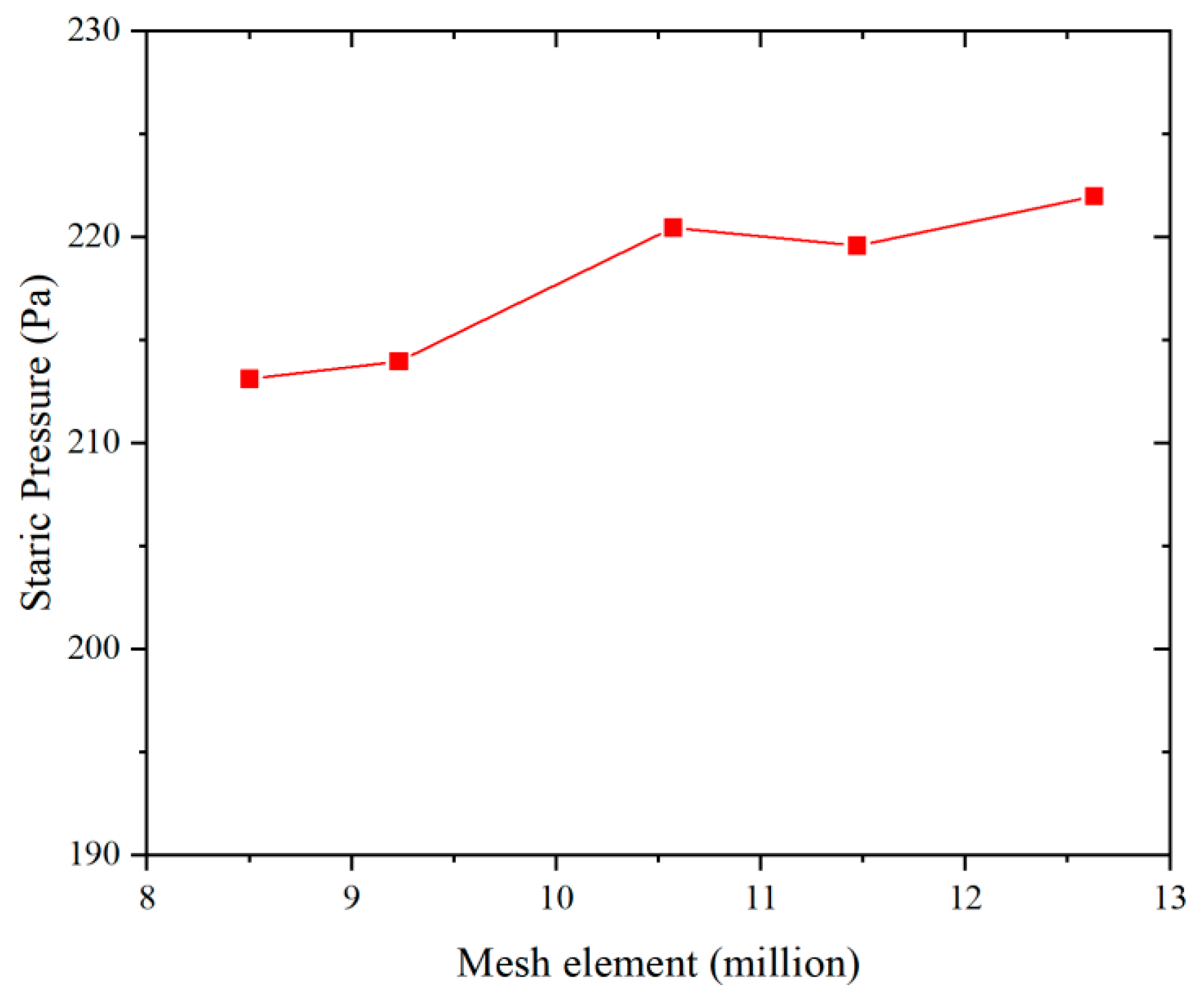

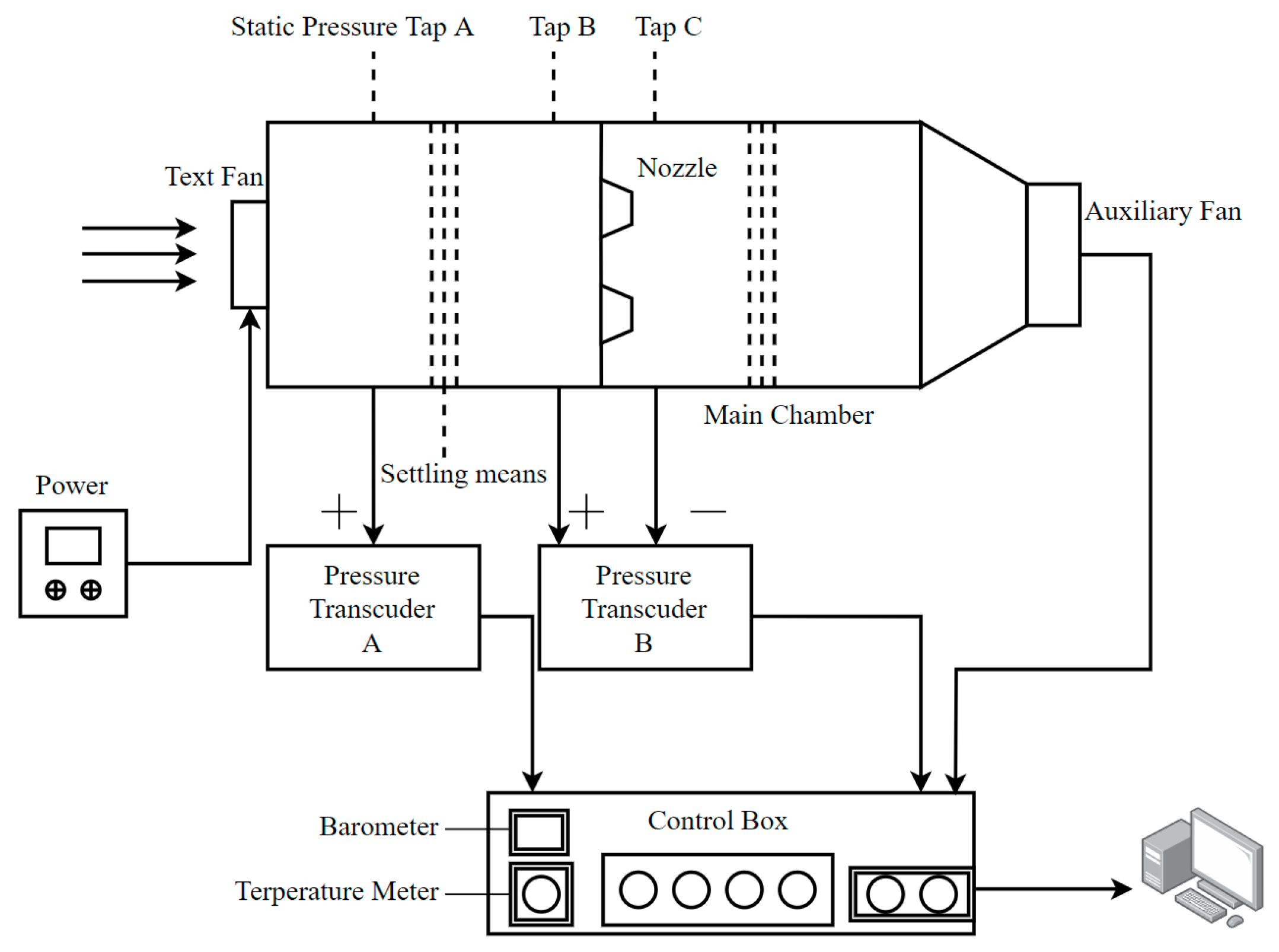
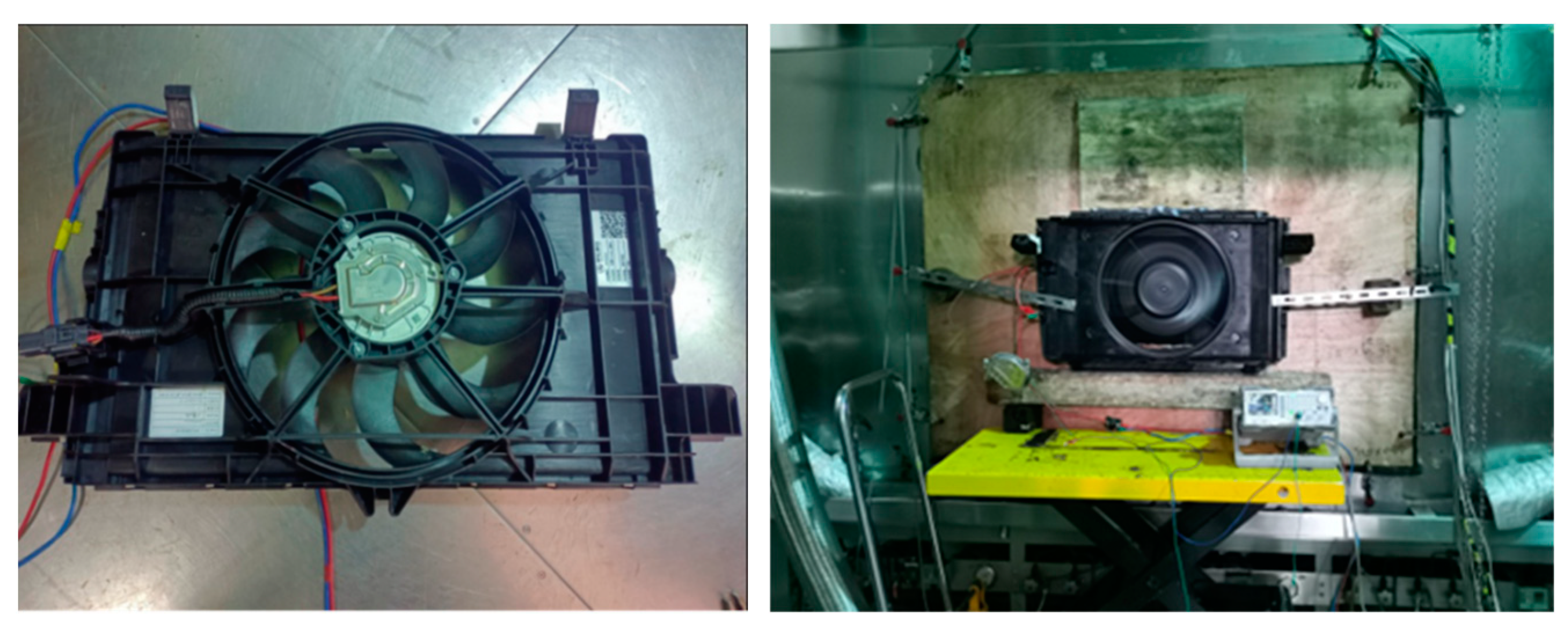


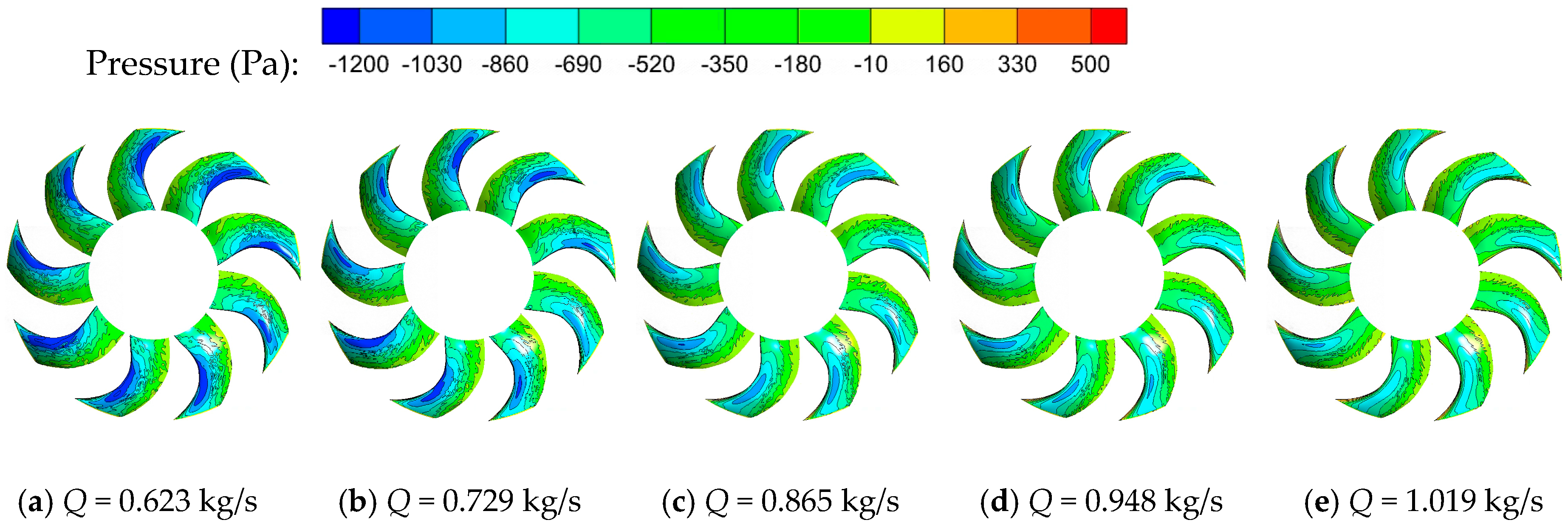


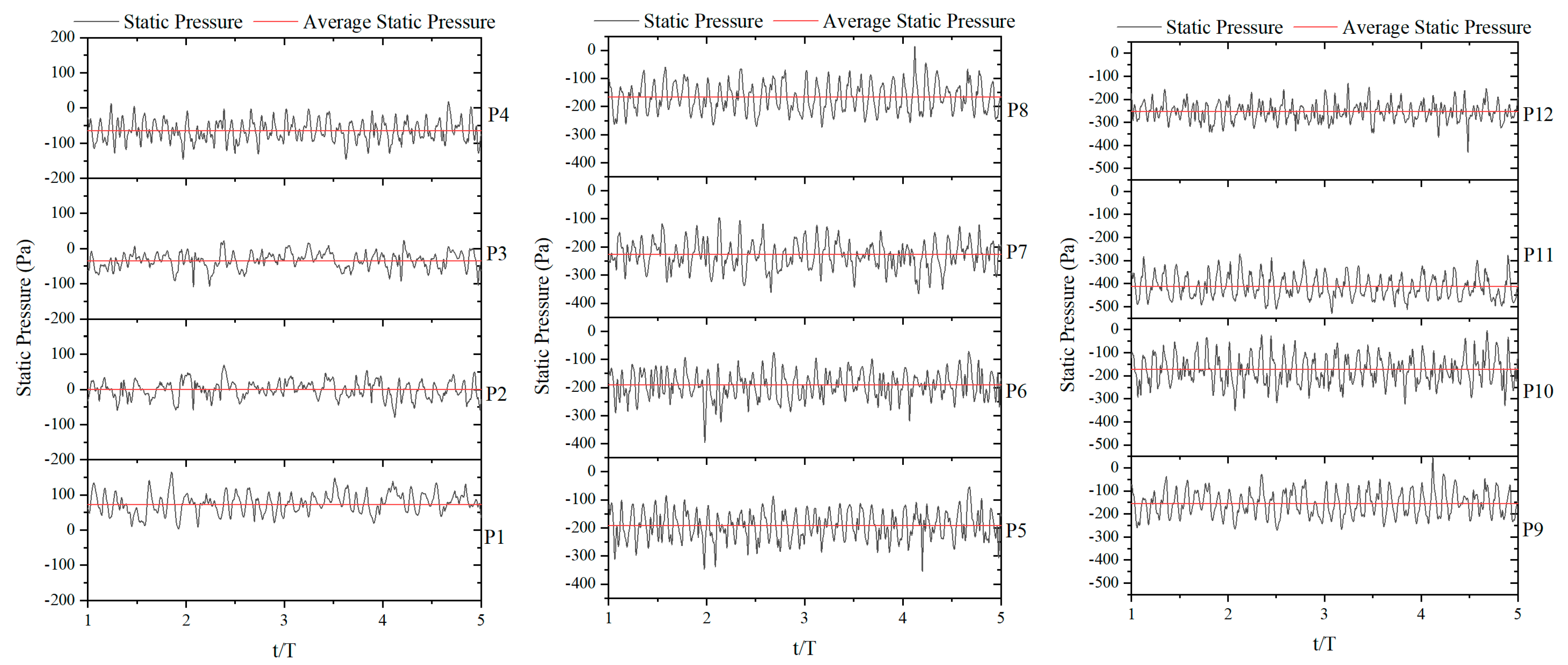
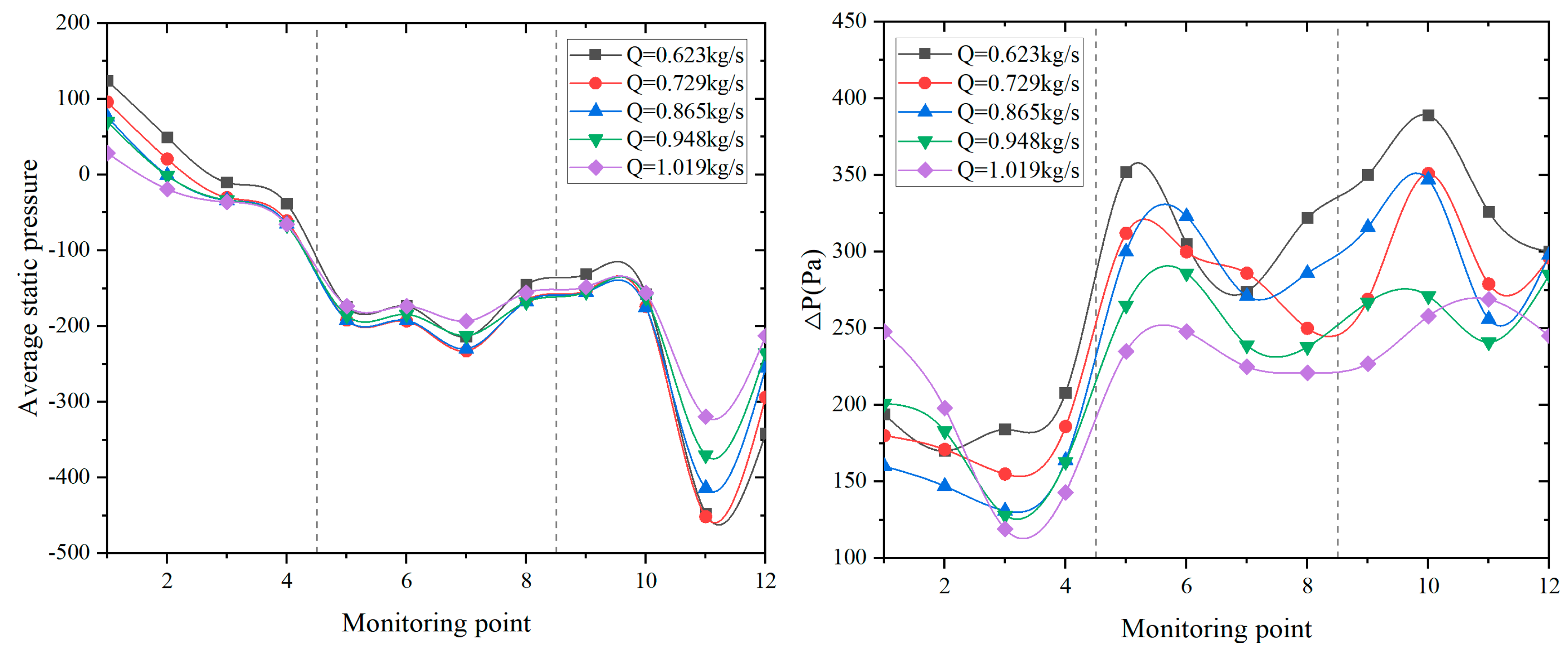

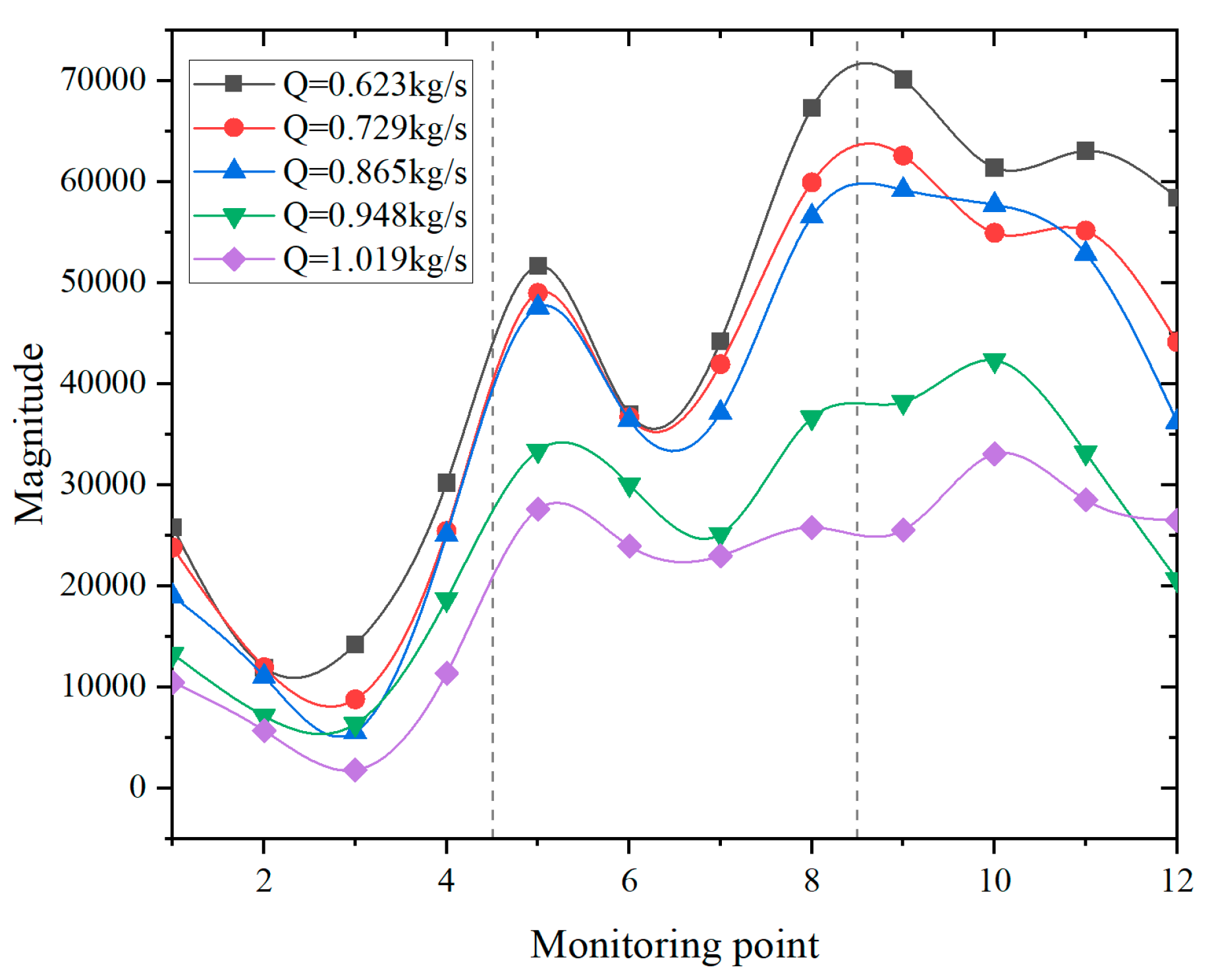
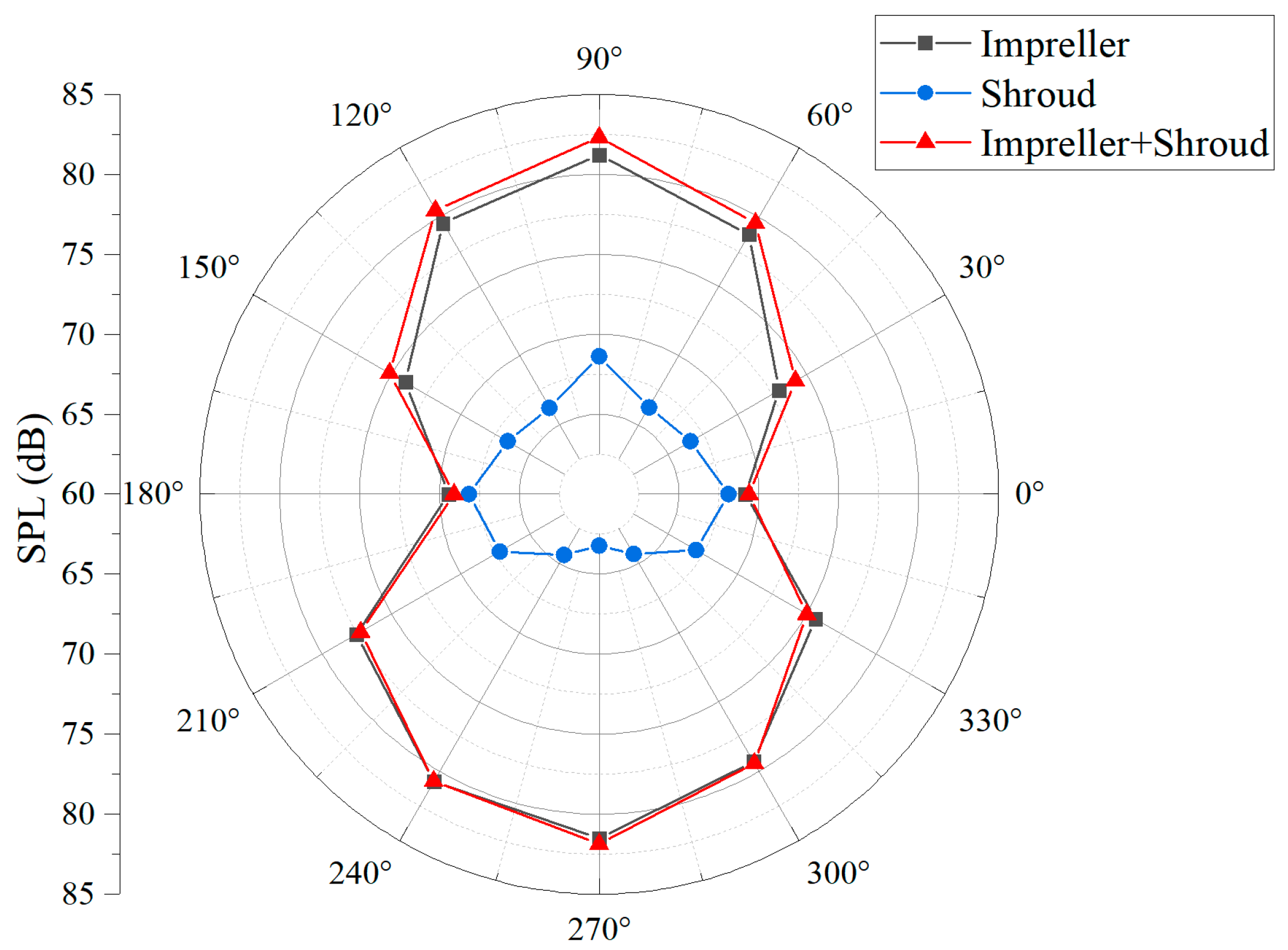


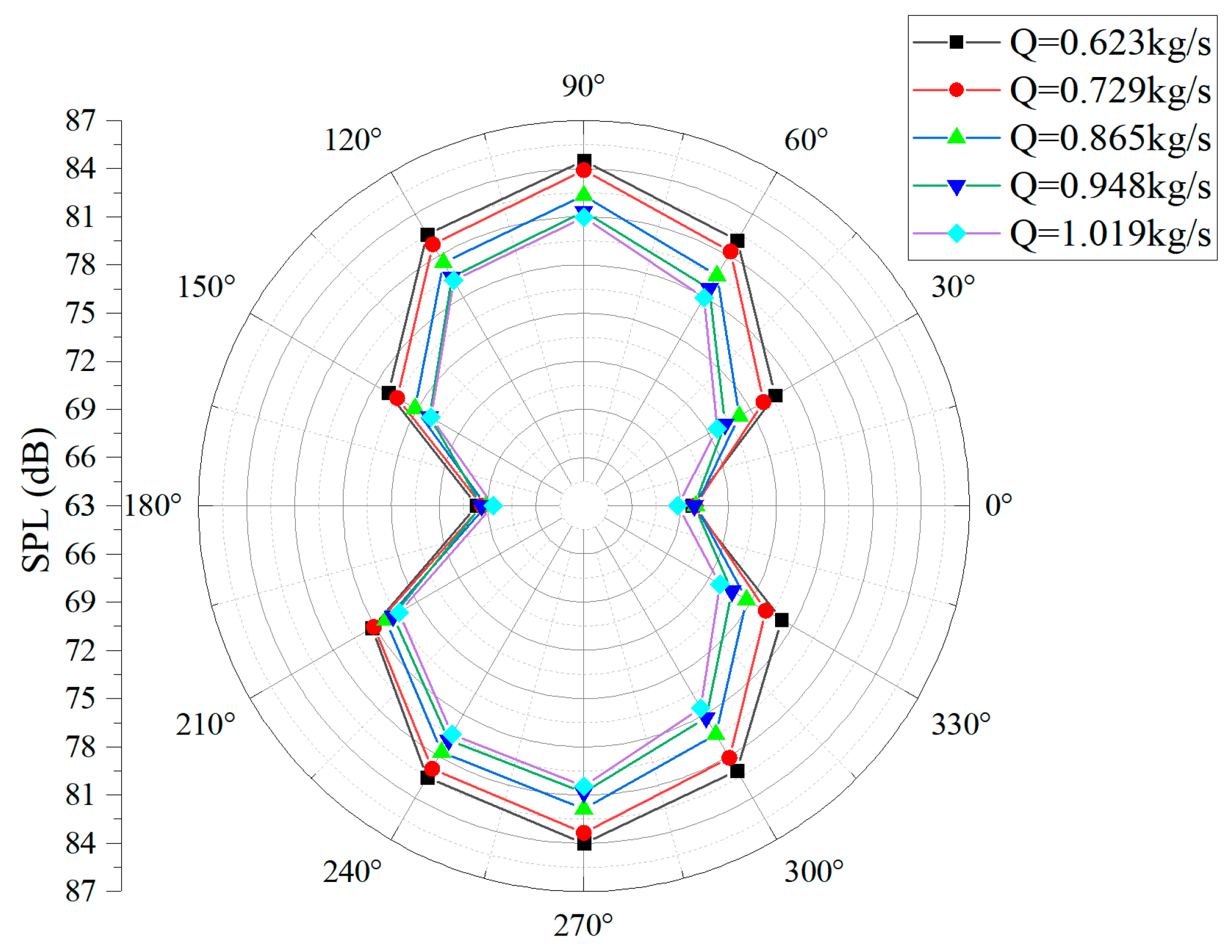
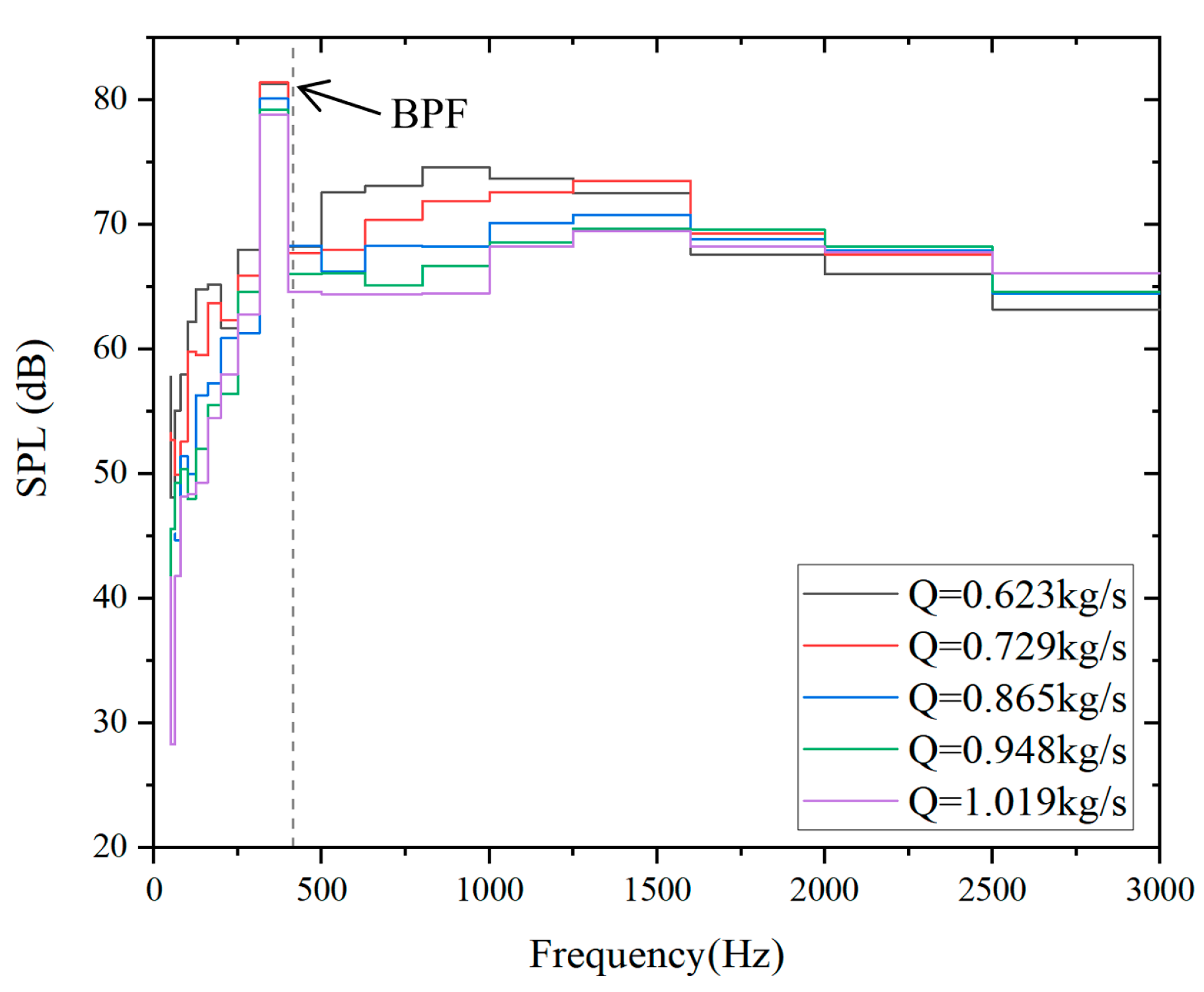


| Specification | Value |
|---|---|
| r1 (mm) | 80 |
| r2 (mm) | 180 |
| Rotation speed of impeller (rpm) | 2770 |
| Number of blades, Z | 9 |
| Domain | Number of Grids (104) |
|---|---|
| Rotating | 720 |
| Stationary | 337 |
| Total | 1057 |
Disclaimer/Publisher’s Note: The statements, opinions and data contained in all publications are solely those of the individual author(s) and contributor(s) and not of MDPI and/or the editor(s). MDPI and/or the editor(s) disclaim responsibility for any injury to people or property resulting from any ideas, methods, instructions or products referred to in the content. |
© 2024 by the authors. Licensee MDPI, Basel, Switzerland. This article is an open access article distributed under the terms and conditions of the Creative Commons Attribution (CC BY) license (https://creativecommons.org/licenses/by/4.0/).
Share and Cite
Huang, B.; Xu, J.; Wang, J.; Xu, L.; Chen, X. Numerical Investigation on the Aerodynamic and Aeroacoustic Characteristics in New Energy Vehicle Cooling Fan with Shroud. Processes 2024, 12, 333. https://doi.org/10.3390/pr12020333
Huang B, Xu J, Wang J, Xu L, Chen X. Numerical Investigation on the Aerodynamic and Aeroacoustic Characteristics in New Energy Vehicle Cooling Fan with Shroud. Processes. 2024; 12(2):333. https://doi.org/10.3390/pr12020333
Chicago/Turabian StyleHuang, Baoding, Jinqiu Xu, Jingxin Wang, Linjie Xu, and Xiaoping Chen. 2024. "Numerical Investigation on the Aerodynamic and Aeroacoustic Characteristics in New Energy Vehicle Cooling Fan with Shroud" Processes 12, no. 2: 333. https://doi.org/10.3390/pr12020333
APA StyleHuang, B., Xu, J., Wang, J., Xu, L., & Chen, X. (2024). Numerical Investigation on the Aerodynamic and Aeroacoustic Characteristics in New Energy Vehicle Cooling Fan with Shroud. Processes, 12(2), 333. https://doi.org/10.3390/pr12020333






